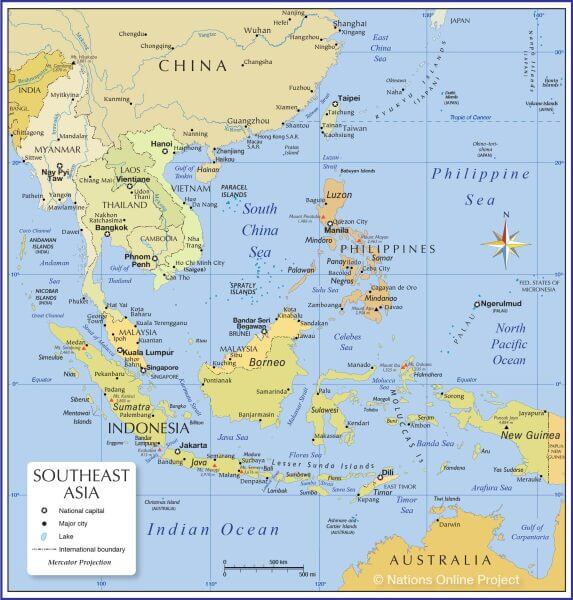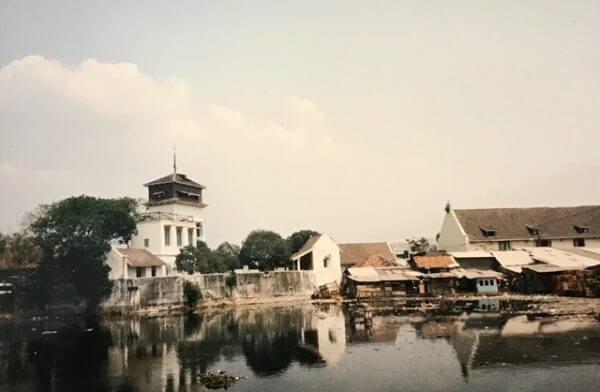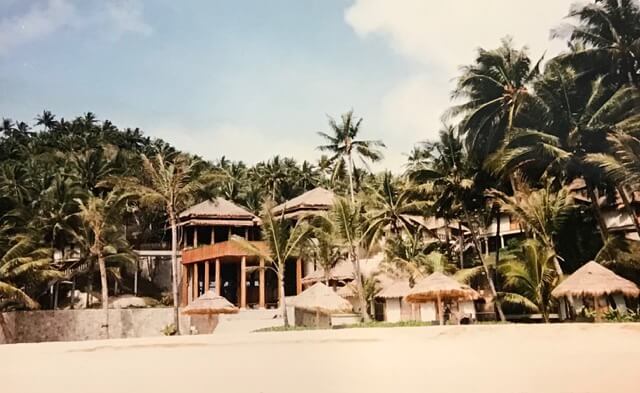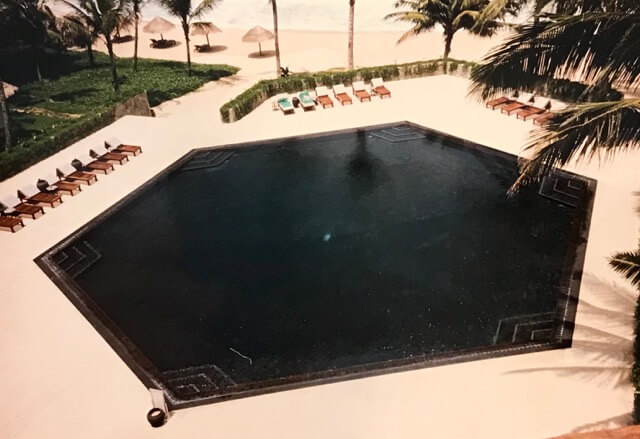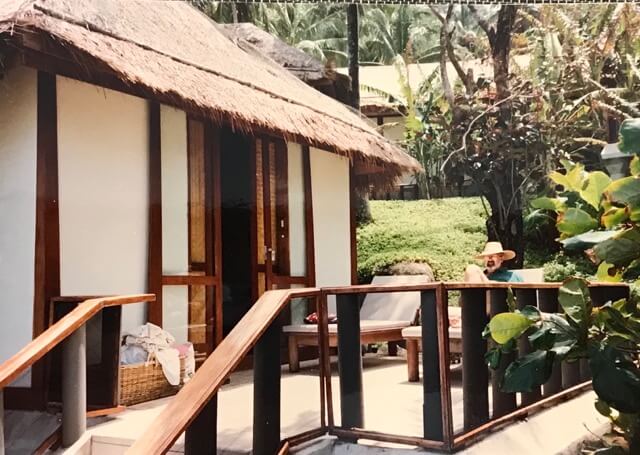#24: Touristing in Southeast AsiaSingapore, Jakarta and Phuket
Living in Laos made it easy to get to other countries in the region. Often I would tag along, at our expense, on study tours that Russell was leading for his Lao Investment team, or we would go early for a few days’ vacation before they arrived. This travel allowed me to make observations and notes for articles I’d later write for the Fredericksburg, VA newspaper. Here are some excerpts from letters home about our tourist experiences.
July 24, 1991
Vientiane, Laos
We got the official invitation from the Indonesians, so we’re going to Singapore and Jakarta. I’ll leave this Sunday for Singapore, and Russ will follow on Thursday. We were to have gone together for a week’s holiday, but he has to remain here for a three-day seminar next week. So I’m off early to take care of some shopping, and when he comes, we’ll just play.
Singapore is a shopper’s paradise, rivaling, if not surpassing, Hong Kong. Among the items on our list: a new printer for my computer, luggage (ours got pretty beat up on the way over), as well as clothes, shoes, fabric, towels and various groceries.
You may recall that I won the Grand Prize in a Mueslix contest for which I submitted an entry before we learned we were coming to Laos. I got a letter informing me that they couldn’t hold the trip to Munich until we return to the States, and they won’t pay for us to come from SE Asia. They’re going to give me the money instead — $4800! We could use a chest-of-drawers, so I’m hoping to spend at least some of that on a tansu, if I can find one in Singapore.
In addition to shopping, one can have a Singapore Sling in the famous Raffles Hotel (at $200 per night, too rich for our blood) and lunch in the former private club where the Duke of Windsor stayed when he was the Prince of Wales. As you probably know, Singapore is one of the world’s major trading and financial powerhouses. It has the world’s second-busiest port, the second-largest oil refinery center and the fourth-largest financial center. It’s very urban, very modern and very controlled by the government.
Singapore is for fun; we’re going to Jakarta on business. Russell will be leading four Lao colleagues on a study tour for conversations with counterparts about how the Indonesians manage foreign investment. There’s lots to see and do in Jakarta, too, so I doubt I’ll get bored waiting for them to get out of meetings.
August 13, 1991
Singapore and Jakarta, Indonesia
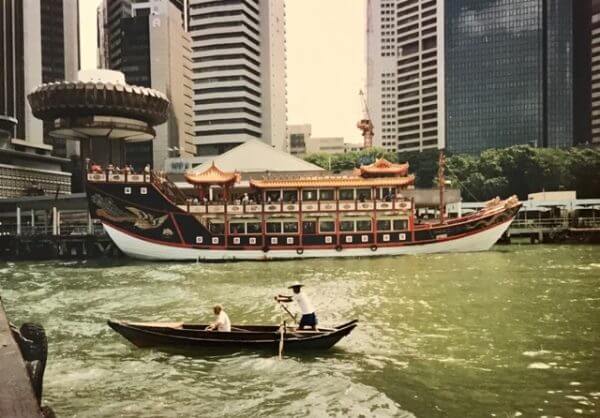 Singapore is just another big city. True, most of the faces are Chinese, and it’s in the tropics, but the city itself is largely unremarkable — a bunch of nondescript high-rise buildings for the most part. They’ve torn down most of the older buildings which gave Singapore its distinctive character. At the last minute, they’ve realized that tourists want to see these historic buildings, so they’re preserving and restoring a couple of blocks of the old Chinese shop-houses. But it’s almost too little, too late. They were restoring the famous Raffles Hotel, which is a good thing in the long run, but a bad thing for us in the short-run — no Singapore Slings in the bar where they were invented.
Singapore is just another big city. True, most of the faces are Chinese, and it’s in the tropics, but the city itself is largely unremarkable — a bunch of nondescript high-rise buildings for the most part. They’ve torn down most of the older buildings which gave Singapore its distinctive character. At the last minute, they’ve realized that tourists want to see these historic buildings, so they’re preserving and restoring a couple of blocks of the old Chinese shop-houses. But it’s almost too little, too late. They were restoring the famous Raffles Hotel, which is a good thing in the long run, but a bad thing for us in the short-run — no Singapore Slings in the bar where they were invented.
It was basically a shopping holiday in Singapore — not exactly my idea of how to spend a vacation. I’m more for sightseeing and/or beaches and mountains. We did take an interesting harbor cruise on a modified junk, but that was the only sightseeing we managed.
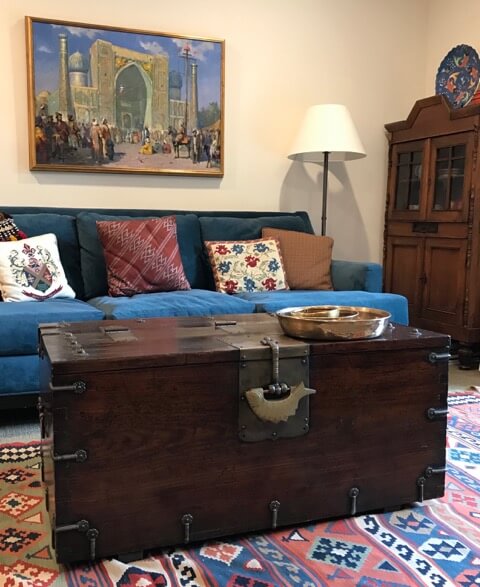 Sadly, there wasn’t room for it in our retirement community apartment, but the trunk now does double duty as a funky coffee table with storage inside.]
Sadly, there wasn’t room for it in our retirement community apartment, but the trunk now does double duty as a funky coffee table with storage inside.]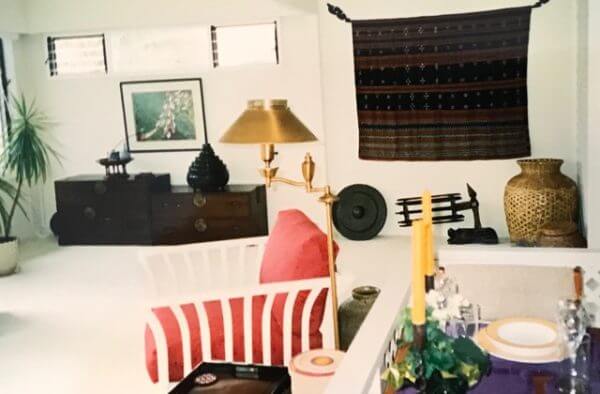
Jakarta was, for me, more interesting, although Russell had to work and so could enjoy only a few of the sights. Indonesia is a fascinating country, very diverse in terms of culture and natural beauty. I hope we’ll be able to go again when we have more time. The country’s islands stretch across a distance equal to that from California to Bermuda, so you can imagine how long it would take to visit even the main ones.
I’d been thinking of perhaps taking a three-day side-trip to Jogjakarta and the ancient Buddhist ruins of Borobudur, but I decided that such a fast trip didn’t make any sense. It seemed better to concentrate on seeing the Jakarta area really well and hope for a return trip with more time to truly view, experience and understand.
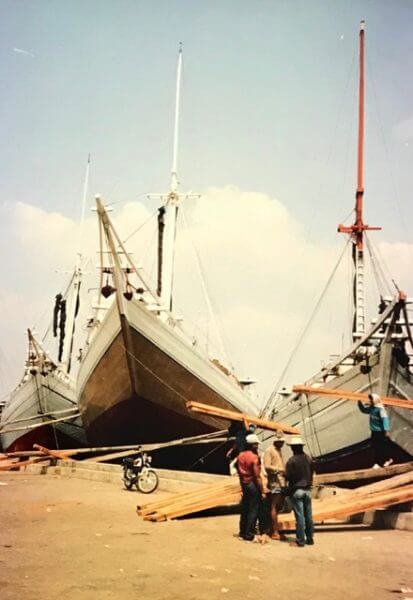 I toured the old harbor, where wooden schooners still ply among the islands, carrying all sorts of goods. The morning that I was there, I saw them off-loading rough-cut mahogany, cement and Texas grapefruit(!). The ships are colorfully painted, and with their furled sails, make quite a sight. They’re in great contrast to the cargo containers and oil tankers of Singapore harbor. Jakarta has its modern port, too, but the old harbor, dating from the 17th century, when it was the Dutch port of Batavia, was more interesting.
I toured the old harbor, where wooden schooners still ply among the islands, carrying all sorts of goods. The morning that I was there, I saw them off-loading rough-cut mahogany, cement and Texas grapefruit(!). The ships are colorfully painted, and with their furled sails, make quite a sight. They’re in great contrast to the cargo containers and oil tankers of Singapore harbor. Jakarta has its modern port, too, but the old harbor, dating from the 17th century, when it was the Dutch port of Batavia, was more interesting.
I climbed the only remaining tower from the old Dutch fort and toured the maritime museum. From the tower, you can see two centuries-old warehouses surviv-ing from early Dutch times and still in use. The museum is full of ship models of most of the Indonesian types of boats, many of them taller than me. I was especially sorry Russell couldn’t be along; he loves boat models.
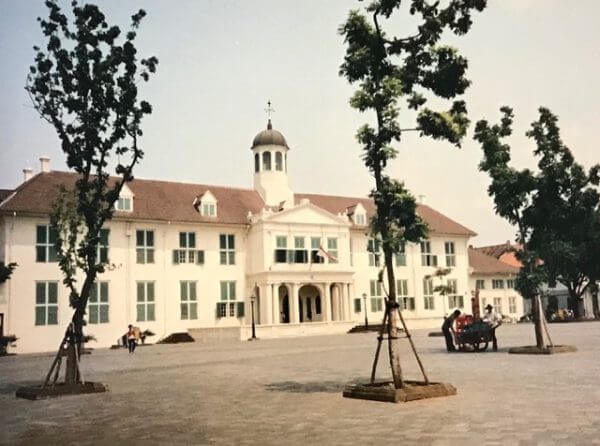 Another day, I walked around the Kota, the center of the old Dutch colony, with several buildings, including the Stadhuis (city hall) still standing. In a fever of nationalism, the Indonesians tore down a lot of the colonial buildings, because the Dutch had been such harsh masters (perhaps the cruelest colonists in the history of the world). But some remain standing and are now open. The Stadhuis is full of two- and three-centuries-old Dutch furniture, unpolished and uncared-for. They don’t make furniture like that anymore. You couldn’t even find wood of that quality.
Another day, I walked around the Kota, the center of the old Dutch colony, with several buildings, including the Stadhuis (city hall) still standing. In a fever of nationalism, the Indonesians tore down a lot of the colonial buildings, because the Dutch had been such harsh masters (perhaps the cruelest colonists in the history of the world). But some remain standing and are now open. The Stadhuis is full of two- and three-centuries-old Dutch furniture, unpolished and uncared-for. They don’t make furniture like that anymore. You couldn’t even find wood of that quality.
I visited the National Museum, full of countless treasures from all periods of the islands’ history — Buddhist and Hindu statues, textiles from cultures known for the sophistication of their weaving, porcelains and ceramics, myriad examples of the gamelan (Indonesian percussion orchestra), puppets, models of villages, examples of the kris (wavy dagger carried until recently by every male in the islands, often decorated with ivory, gold and precious stones), implements from everyday life throughout the islands, costumes for court dancers, bronze rain drums, a special exhibit on Java Man (one of the most ancient ever found), and a treasure room of gold objects from various courts of the islands — jewelry and boxes and belts and cups and kris-handles and 100 other things. I’m sure I’ve left out lots of details. I could easily have spent several days in the museum just trying to get a general idea of all that’s there. I bought a necklace made from a nautilus shell with old silver beads and silver chain from the museum shop — lots more distinctive than Mikimoto pearls.
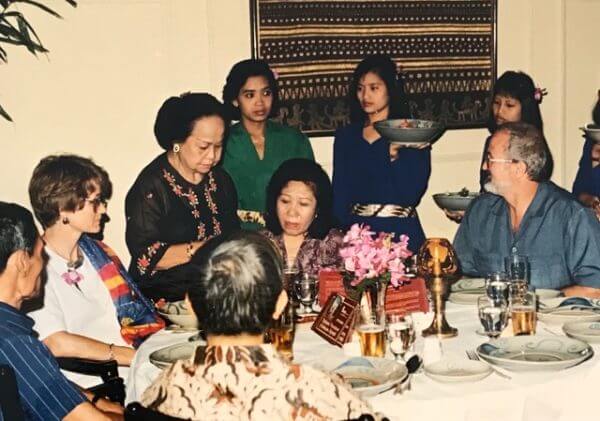 One of the fun things we did together was to take Russell’s Lao colleagues and the Lao Ambassador and his wife to a former Dutch colonial mansion, now a restaurant which serves Rijsttafl, the traditional fare of many dishes served all at once. We had three hors d’oeuvres, plus 14 dishes, each carried by a different waitress in traditional costume — beef and chicken and shrimp and vegetables and satay (small shish kebabs), roasted coconut, and eight more. Next, we had bananas flambé, followed by crystallized fruits and then chocolates. During the meal, we were serenaded by a lively group from Sumatra. The whole thing was a bit touristy, but much appreciated.
One of the fun things we did together was to take Russell’s Lao colleagues and the Lao Ambassador and his wife to a former Dutch colonial mansion, now a restaurant which serves Rijsttafl, the traditional fare of many dishes served all at once. We had three hors d’oeuvres, plus 14 dishes, each carried by a different waitress in traditional costume — beef and chicken and shrimp and vegetables and satay (small shish kebabs), roasted coconut, and eight more. Next, we had bananas flambé, followed by crystallized fruits and then chocolates. During the meal, we were serenaded by a lively group from Sumatra. The whole thing was a bit touristy, but much appreciated.
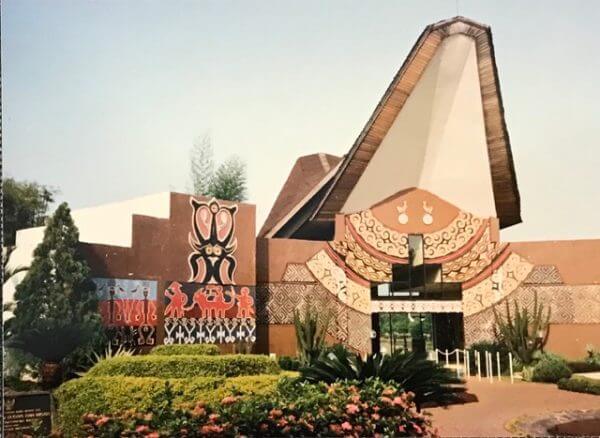 Since I couldn’t travel all over Indonesia, I went to Taman Mini-Indonesia Indah and saw examples of all the main housing styles of the islands, as well as temples, a museum and a huge aviary with Indonesian birds. I especially enjoyed an IMAX film on an enormous screen, because it showed all the natural and cultural attractions of the islands. It really made me want to stay — or come back with more time — and see Java, Sumatra, Bali, Borneo, Irian Jaya and all the rest.
Since I couldn’t travel all over Indonesia, I went to Taman Mini-Indonesia Indah and saw examples of all the main housing styles of the islands, as well as temples, a museum and a huge aviary with Indonesian birds. I especially enjoyed an IMAX film on an enormous screen, because it showed all the natural and cultural attractions of the islands. It really made me want to stay — or come back with more time — and see Java, Sumatra, Bali, Borneo, Irian Jaya and all the rest.
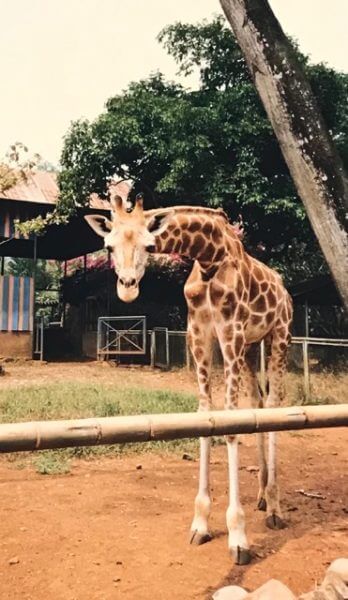 I spent a morning at the zoo, seeing all the animals which are unique to Indonesia — ten-foot Komodo dragons, Sumatran tigers and elephants, Javan rhino and the babirusa, a curious animal that looks like a pig, has teeth that stick up like deer horns and the stomach of a ruminant. The zoo also sheltered some old friends — zebras and giraffes from East Africa.
I spent a morning at the zoo, seeing all the animals which are unique to Indonesia — ten-foot Komodo dragons, Sumatran tigers and elephants, Javan rhino and the babirusa, a curious animal that looks like a pig, has teeth that stick up like deer horns and the stomach of a ruminant. The zoo also sheltered some old friends — zebras and giraffes from East Africa.
When Russell had some free time, we toured art galleries and craft shops. Indonesia is rich in arts and crafts — painting, textiles, wood-carving, basketry, etc. We got some representative samples of each. I discovered that I have excellent taste in batiks: the one I liked was $100 per yard! (I didn’t get it.) We also ate some nice food we don’t have in Vientiane; e.g., wiener schnitzel, waffles, scallops and the wonderful breads which are a Dutch legacy.
Although we had a lot of fun, perhaps the best news of all was that the study tour for the Lao was very successful, resulting in several breakthroughs as far as the project was concerned. It really helps to see what other people in the region are doing with regard to attracting and managing foreign investment.
***
A lot of our trips combined business and pleasure, but some were just for R&R.
August 29, 1991
Vientiane, Laos
If all goes well, we’re going to the beach next week for a few days. As you know, R’s planned vacation in Singapore was curtailed when he had to stay here for business. It’s not unusual for him to work from 8 am to 7 pm on both days of the weekend. The next three months will be filled with lots of business and stress for both of us. When R’s short-term consulting team leaves, we’ve got a window of opportunity. Russell suggested we grab some time at Phuket, the island-resort on the West coast of Thailand. Since I’ve got the beginnings of a cold, it sounded like a good idea to me. We’re hoping for no decisions other than whether to have bacon or sausage for breakfast.
September 10, 1991
Phuket, Thailand
We had a lovely time in Phuket and look forward to going again when we can stay longer. The Hotel Pan Sea is very special. They definitely succeeded in their goal of low environmental impact with interesting architecture.
Guests stay in bungalows on stilts like traditional Southeast Asian houses. However, these bungalows have all mod cons — stocked fridge, dressing and bathroom combined in a room larger than most folks have at home, a large bedroom with two desks and a sofa. Interior floors are of natural wood, and the interior sliding doors, sliding window-covers and bed headboard are of woven palm fronds in a wooden frame. Glass sliding doors lead onto your private deck with two chaises longues. The roof of the bungalow is thatch over some sort of modern material, so you get the advantage of the look without resident vermin and rain-drips.
The central building is five stories high, but because it cascades down the hillside to the sea, it doesn’t seem monolithic. You enter from the roadway onto the top floor, where you find reception, concierge, boutiques, offices, etc. Down another level are two pavilions open to the sea where they offer three full meals a day. The next level down houses a library stocked in five languages (Thai, English, French, German and Japanese), including the latest economic journals(!). Continuing down, you come to the coffee shop and bar, also open on the sea-side, with game and video rooms behind. The last level is the pool, an octagon in black tile, with the deep end in the middle, so the kiddies can’t fall in and drown. (They have their own pool.) The whole structure is in natural wood and stone. A few steps more, and you’re on the beach, with thatched umbrellas and chaises longues.
The beach itself is gorgeous, perhaps a half-mile of white sand bounded on each end by rocky promontories. The water is, of course, turquoise-blue, with enough surf to be interesting. Looking back at the hotel from the beach, you see a traditional village among palm trees, bougainvillea and other tropical plants.
Because it was off-season, only about five bungalows were occupied at any one time, and we had an enormous discount, paying $70 per night, including an American breakfast. Needless to say, during the season, the price is quite a bit steeper.
We had a glorious time doing nothing — sitting on the beach, reading, swimming, walking, shelling, etc. It was great just to relax after all our busy-ness in the months since we arrived in Vientiane.

COMING NEXT MONTH
Touristing in Southeast Asia
Ayutthaya, Sukhothai, Chiang Mai,
Cameron Highlands and Hong Kong

LET ME HEAR FROM YOU.
Please take a moment to share your thoughts.
Your comments help make the blog better, and I always answer.
* * *
If you enjoyed reading this post, I hope you’ll SUBSCRIBE by clicking on the button below. Every month, when I post a new excerpt from my life overseas, you’ll get an email with a link so you can read the next installment. Subscription is free, and I won’t share your contact information with anyone else. Your subscribing lets me know you’re reading what I write, and that means a lot.

